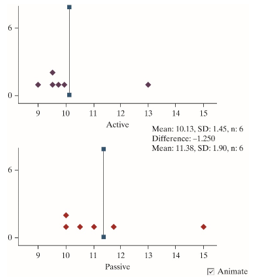Multiple Choice
When newborns are held so that their feet just barely touch the floor, they will make instinctive walking and placing motions. This reflex disappears by about eight weeks. Researchers wanted to know if stimulating this behavior in infants during their first eight weeks of life would lead them to walk at an earlier age compared to infants who do not receive this stimulation. To test this they had twelve infants randomly assigned to two groups. Six infants received stimulation of the walking and placing reflex (active group) and six infants receive equal amounts of gross motor and social stimulation, but did not received stimulation of the walking and placing reflex (passive group) . The researchers then compared the infant's age (in months) when they first walked and the results are shown in the following figure. 
-In evaluating the relationship between whether an infant received stimulation of the walking and placing reflex and the infant's age when they first walked, would a theory-based approach be valid?
A) Yes, since 12 is larger than 10.
B) No, since 6 and 6 are both less than 20 and each sample has an outlier.
C) Yes, since we are testing a difference in means.
D) No, since the researchers did not use a random sample.
Correct Answer:

Verified
Correct Answer:
Verified
Q1: Do children diagnosed with attention deficit/hyperactivity disorder
Q2: In order to investigate whether talking on
Q3: Monthly snowfall (in inches) was measured over
Q4: Do children diagnosed with attention deficit/hyperactivity disorder
Q6: In order to investigate whether talking on
Q7: The boxplots below display the distribution of
Q8: The boxplots below display the distribution of
Q9: The plot below displays the on-base percentage
Q10: An article that appeared in the British
Q11: The boxplots below display the distribution of